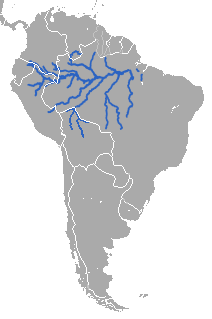Amazonian manatee
| Amazonian manatee | |
|---|---|
 |
|
| Scientific classification | |
| Kingdom: | Animalia |
| Phylum: | Chordata |
| Class: | Mammalia |
| Order: | Sirenia |
| Family: | Trichechidae |
| Genus: | Trichechus |
| Species: | T. inunguis |
| Binomial name | |
|
Trichechus inunguis (Natterer, 1883) |
|
 |
|
| Amazonian manatee range | |
The Amazonian manatee (Trichechus inunguis) is a species of manatee of the order Sirenia. It is found living in the freshwater habitats of the Amazon Basin in Brazil, Peru, Bolivia, Colombia and Ecuador. It has thin, wrinkled skin, and is almost hairless, but has "whiskers" around its mouth. It also has a distinct white breast patch, with fine hairs scattered over its body. It is also known as the Amazon manatee or sea cow.
The Amazonian manatee is the second-smallest species of manatee after the dwarf manatee (Trichechus pygmaeus) from Brazil. However, the validity of the dwarf manatee as a species is the subject of debate, with some believing it to be an immature Amazonian manatee.
The specific name, inunguis is Latin for "nailless." The genus name Trichechus, comes from Latin meaning "hair", referencing the whiskers around the manatee's mouth.
Ranges of body weight and size observed are 7.5–346.5 kg and 76.0 –255.5 cm for captive males, 8.1–379.5 kg and 71.0–266.5 cm for captive females, and 120.0–270.0 kg and 162.0 –230.0 cm for free-ranging manatees, respectively. The maximum actual Amazonian manatee weight reported is 379.5 kg. Calves of the species are born weighing 10–15 kg and 85 –105 cm long. The Amazonian Manatees increase in length approximately 1.6-2.0 mm per day. This length is measured along the curvature of the body so absolute length can differ between individuals. As calves, they gain an average of 1 kilogram per week.
Amazonian manatees are large, cylindrically shaped mammals, with forelimbs modified into flippers, no free hind-limbs, and the rear of the body in the form of a flat, rounded, horizontal paddle. The flexible flippers are used for aiding motion over the bottom, scratching, touching and even embracing other manatees, and moving food into and cleaning the mouth. The manatee's upper lip is modified into a large bristly surface, which is deeply divided. It can move each side of the lips independently while feeding. The general coloration is gray, and most Amazonian manatees have a distinct white or bright pink patch on the breast.
...
Wikipedia

